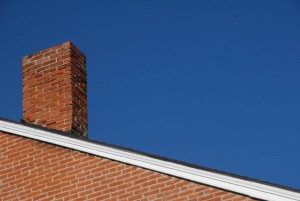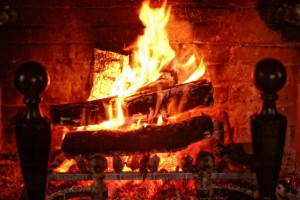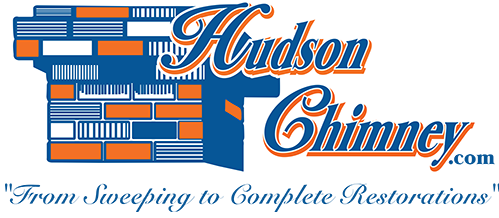by Mark Hudson | Sep 4, 2015 | Draft and Flow
Unpleasant odors coming from the fireplace can, unfortunately, be common problems in the summer due to draft and flow chimney issues. Although fireplace odor issues can be the result of creosote accumulations or birds or animals living inside the chimney, quite often the bad smell is simply old smoky air from the chimney. According to the Chimney Safety Institute of America (CSIA), the air flow in your house is constantly moving, even though you cannot see it. Most often, air tries to flow out through the upper parts of your home, and air flows into the house through its lower part to try to replace the air that left. To better understand draft and flow, Hudson Chimney would like to tell you more about some of the things that influence the actual flow of air into and out of your home.

WIND-LOADING
The effect on interior house pressures caused by the wind, wind-loading takes place when wind hits your home and creates high pressure on the side it hits and low pressure on the downwind side. If you open windows or doors on the windward side, this will help both to pressurize the house and increase the chimney draft. On the other hand, if you have your windows or doors on the downwind side opened, this can depressurize the house and allow the smoky air from the chimney to enter your home by backdrafting.
INTERIOR MECHANICAL DEVICES
Clothes dryers, kitchen, attic, and bathroom fans, and central vacuum systems can remove large volumes of air and cause depressurization that leads to backdrafting. This often results in negative pressure around your fireplace, stove, or other heating appliance. Forced-air furnaces also take a large amount of air away from a home. When these systems have leaky ducts, it can negatively affect draft by causing air to be blown into the attic or crawlspace.
WEATHERIZATION
When you get your house weatherized to keep cooled air in during the summer and heated air in during the winter, you can possibly seal your home off too tightly to the point where air cannot flow properly. This leads to the stack effect, which is where warm air rises to the highest level and creates a pressurized area. The stack effect can be behind several chimney draft issues.
Noticing signs of chimney draft problems this summer? Contact us at Hudson Chimney to find out how we can help you solve these issues.
by Mark Hudson | Jul 10, 2015 | Chimney Draft Issues
Since your chimney is a venting system, draft issues can affect the performance of your fireplace and chimney. Draft problems can cause different outcomes, and repairing a draft issue depends on what is causing the problem. At Hudson Chimney, we often get calls from customers who are unsure if and how draft could be affecting their chimneys. We thought we would share some information from Mother Earth News about how to tell if you have a drafty chimney and how to identify what is causing the problem.

You have a hard time lighting a fire.
If you cannot seem to get a good fire burning in your fireplace, there is a good chance your chimney is too cold. Cold temperatures have an effect on chimney draft. If you feel cold air coming from your fireplace, you may need to prime the flue before starting a fire. Simply light a rolled-up newspaper and hold the flame as high as you can into your chimney until you can feel the draft reverse.
Smoke blows into your house from the fireplace.
Sometimes, this problem can be solved simply by repairing the damper to ensure it fully opens to allow smoke to properly exit out of the chimney. However, other things can lead to smoky fireplaces, including cold chimneys. The size of your flue can also cause draft issues that lead to smoke blowing into your home through the fireplace. If you only notice a smoky fireplace on windy days, you may need a new chimney cap to keep wind patterns from reducing the chimney flow. You can contact Hudson Chimney to take care of these problems that are causing draft issues for your chimney.
You notice unpleasant odors coming into your home from your fireplace.
If your home is noticeably smoky smelling and you are not burning a fire in your fireplace, negative air pressure is most likely the reason for the odor entering your house through the fireplace from the chimney. Many times when people weatherize their homes to heat and cool more efficiently, they can seal up windows and doors too tightly. This creates the need for more air to be brought into the home through the fireplace, and this air brings along the smoky smells of the chimney. An easy way to combat negative air pressure is to slightly open up a window to allow more air to enter the house.
Are you dealing with any of these chimney draft issues? Contact Hudson Chimney to schedule a consultation with our Chimney Safety Institute of America (CSIA)-certified chimney sweeps to professionally diagnose and solve this problem for you. We work hard to keep your fireplace and chimney working safely and properly.
by Mark Hudson | Dec 27, 2013 | chimney maintenance
Is air coming into your home through the firebox? Does your house smell of smoke days after you burned a fire in your fireplace? Do you have a hard time either starting a fire or keeping the fire going once you’ve gotten it started? If you can answer yes to any of these questions, you could definitely have a problem with your chimney system’s draft. We can help you figure out how your drafting problem began in the first place, which can help you prevent similar problems from happening down the road.

A drafty chimney can cause smoke to enter the and circulate in the house.
Drafty Chimney Symptoms
There are many symptoms of a drafty chimney. Is your fire reluctant to start, and/or does smoke spill into the room at start-up? Does your firebox back-puff powerfully on windy days? Does smoke spill, to some degree, under all conditions? Does smoke spill at larger damper openings? Is the heat output from your fireplace too low? Are smoke odors persistent even when the fireplace isn’t in use? If you answered yes to one or more of the above-listed questions, you might have a drafty chimney. We suggest having your chimney inspected.
Drafty Chimney Remedies
Our CSIA-certified chimney sweeps can determine which, if any, of the afore-mentioned issues are impacting your home. There are numerous possible remedies depending on which problem (or combination of problems) is the culprit. Oftentimes, sweeping the chimney can take care of the issue, as even the slightest buildup inside your chimney can restrict airflow. Sealing leaks in the chimney is another possible remedy, depending on what is found during your inspection. Another quick fix would be installing or replacing your chimney cap; back-puffing problems during windy conditions point directly to this.
Poor Drafting Leads to Increased Levels of Harmful Gases
It is extremely important to deal with drafting problems as soon as you notice them, as ignoring it can have adverse affects on your health. These problems can cause combustion products to back up and enter your home leaving behind unpleasant and unsafe living conditions. Fixing your drafting problem will enable the harmful gases and smoke from the fire to properly exit your home through the chimney flue. Even though you may be able to alleviate most of the excess smoke in your home on your own, the health affects associated with a back draft compel you to consult with a chimney professional to ensure that your home is safe for you and everyone in it.
A little peace of mind can go a very long way. You’ll find that you are better able to enjoy that roaring fire fully knowing that you and your family are safer in your home. One of our CSIA-certified chimney sweeps can inspect your chimney system for you and can help fix your poor-drafting issue(s) once and for all. Don’t wait until it’s too late. Give us a call today!



